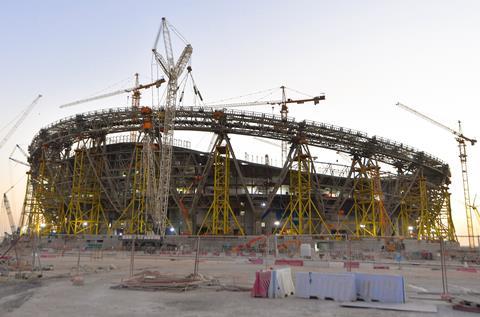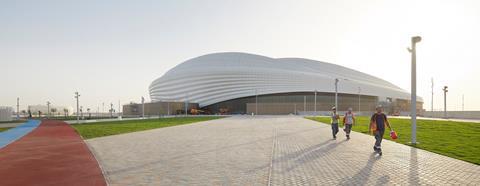For Qatar 2022, Zaha Hadid Architects, Foster + Partners and BDP Pattern were given mission impossible: create open-air arenas where players and spectators are protected from temperatures of 40ºC. Tom Lowe reports on how they got on

Designing and building stadiums in a country where temperatures in summer can soar above 50ºC is a challenge enough to make any construction worker break into a sweat. When Qatar won the rights to host the 2022 World Cup, many feared for the safety of spectators and players. But the country, among the 10 richest in the world, was not daunted.
In a gutsy rebuke to the doubters, the initial brief given to architects was for stadiums which could host a football match under an open sky at 2pm on a July afternoon. This would be at a time when the sun was near its zenith, beaming directly down into the arena bowl.
“The physics of it are just impossible to overcome,” Zaha Hadid Architects director Jim Heverin says. Even with powerful air conditioning, hot desert winds can appear without warning and quickly blow out the cooled air. And then there are shamals, powerful sandstorms several thousands of feet deep with temperatures above 40ºC and speeds of up to 70km per hour that cover everything in their path with sand, causing flights to be cancelled and public services to be shut down.
“There was nothing you could do to guarantee that that wouldn’t happen,” Heverin says. “There is literally nothing you could do about that risk.”
Three British practices, Zaha Hadid Architects, Foster + Partners and BDP Pattern, have designed stadiums for the world’s most widely watched sporting event
When Fifa decided to allow this year’s tournament to be hosted in November instead of the traditional June to July, Heverin says there was an “immense sense of relief” within his profession. But temperatures even at this time of year can approach 40ºC, and the hosts still wanted the option of using the stadiums once the tournament is over – and during the summer months.
So the architectural teams working on the eight stadiums embarked on what has become one of the past decade’s most ambitious – and, at an estimated cost of around £140bn, most costly – design programmes. Three British practices, Zaha Hadid Architects, Foster + Partners and BDP Pattern, have designed stadiums for the world’s most widely watched sporting event. All faced the same challenge of creating open-air arenas where players and spectators are protected from the heat.
>> Also read: Your guide to the World Cup 2022 stadiums
>> Would you have worked on a World Cup stadium?
Which makes it surprising that the Supreme Committee for Delivery and Legacy, the Qatari client overseeing the work, did not allow the project teams to talk to each other. Designers, engineers and contractors were only permitted to talk to the client, and could not share the results of research they had carried out into how to keep the stadiums cool.
“They were aware that no one has solved this problem, other than by using closing roofs. But I think they were quite keen to see what different solutions teams would come up with,” says BDP Pattern principal Dipesh Patel, who led the design work on two of the tournament’s arenas, the Ahmed Bin Ali Stadium and the Education City Stadium.

Qatar’s approach offers a counter-argument to the drive for greater collaboration that is being encouraged elsewhere in the industry, raising the hypothesis that multiple teams working in silos to solve the same issues are more likely to innovate. “They didn’t want group-think,” Heverin says.
“They wanted everybody to come at it with fresh eyes. They wanted everybody to have their own take on it and not be constrained by somebody else’s work.”
This way of thinking is far from unique to Qatar. Heverin, who was the project lead for the London Aquatics Centre built for the 2012 Olympics, said it was not so different an approach to how teams worked on the development of the Olympic park.
“We weren’t sitting down on a regular basis with the architects for any of the other projects,” he says. “I think we met twice maybe, just to show each other our projects. I think it’s valid to say that, if you want each team to excel and come up with innovative solutions, then this is one approach to do it.”
Zaha Hadid Architect’s Al Janoub Stadium’s undulating facade is designed to direct prevailing winds away from its open roof
The result is that each stadium has found a different way to minimise the effects of the heat, although they all use air-conditioning. Zaha Hadid Architect’s Al Janoub Stadium’s undulating facade is designed to direct prevailing winds away from its open roof. The oculus has also been reduced in size to make it easier for the air-conditioning to cool the stadium, and the building is clad in white aluminium panels to reflect sunlight.
BDP Pattern’s two stadiums also use different approaches, partly because Education City adapted an existing concept by Spanish practice Fenwick Iribarren. This stadium uses large slots in the side of the facade to channel wind through the stadium, creating what Patel calls a “sandwich” of air under the roof to ward off winds coming in through the top.
At Ahmed Bin Ali, which Pattern wholly designed, the practice had the opportunity to come up with a different approach. Patel brought in a professor of aerodynamics from Imperial College, London, to carry out some research, resulting in the construction of a 10m perforated wall around the oculus.
The structure is designed to slow down wind just enough so that it forms a blanket of air on top of the stadium, reducing the effect of eddies which form around the rim of the roof and suck out cooler air from the bowl.

“It’s quite a low-tech idea but a hell of a lot of science went into making it work, including testing in wind tunnels. It works beautifully,” Patel says.
At Fosters’ Lusail Stadium, which will be the centrepiece of the tournament and will host the final match, the facade is punctured by thousands of triangular openings that allow ventilation to the upper seating areas. Head of Studio Luke Fox says the screen will also “provide shade and filter dappled light” into the arena’s interior, reducing the building’s energy consumption.
Lusail Stadium appears to rely more on air-conditioning than those designed by Pattern and Zaha Hadid. This energy-intensive technology will inevitably be a major element in the cooling of all the stadiums, regardless of the efforts of some teams to reduce its role with design innovations.
Last year, a report by Fifa suggested that 3.6 million tonnes of carbon would be emitted during the tournament, more than some countries produce in a year. Qatar has dubiously claimed that the tournament will be the first net zero World Cup in history, a feat which climate group Carbon Market Watch has called “simply not credible”.
“I’m an Indian, a lot of these workers are Indian and I care about them.”
Those working on the stadium designs are also under pressure to justify working in a country which is reported to have seen 6,500 construction worker deaths since 2010, when the World Cup was awarded. Fox says Fosters made “several modifications” to the specifications in its tender documents on welfare provisions for construction workers.
“These changes have subsequently positively influenced our specifications on other projects in the region and other parts of the world,” he says.
Heverin says Zaha Hadid Architects “do what we can to work with clients to ensure the best conditions for the workers”, adding that the practice gives the same health and safety considerations in Qatar that it gives to workers on a European or UK project.

Patel is more direct: “I’m an Indian, a lot of these workers are Indian and I care about them.” He says he made a point of ensuring that workers’ accommodation was of a good standard and that they were treated well.
“I personally did that, I didn’t have to do it,” he says. He is also keen to stress that the World Cup stadiums have been built by international tier one contractors with “global reputations” and “brilliant safety systems”.
There is also the the issue of gay rights in Qatar, where male homosexuality is illegal and Muslims face the death penalty under sharia law. Patel, Heverin and Fox all argue that their work in the country makes a positive contribution by engaging with the host nation as opposed to “freezing them out”.
This year’s World Cup has been a point of controversy ever since Qatar was named as the host, and these questions will only increase in intensity over the next few weeks. The British firms who have worked on the tournament will be grateful to have a positive story to tell.
A controversial tournament
- This year’s World Cup has been marred by controversy since governing body Fifa awarded the hosting rights to Qatar in 2010, and not just because of concerns about the hot weather. Criticism of the country’s human rights record, its stance on same-sex relationships and its treatment of migrant construction workers has ramped up in recent months and is likely to be a running theme throughout the tournament.
- Captains of several European teams, including England’s Harry Kane, will wear a OneLove armband during matches to show they “stand together against discrimination”. Kane says the arm bands, which are part of a campaign to promote diversity and inclusion, will “send a clear message when the world is watching”.
- Denmark has decided to wear “toned down” shirts for the tournament with the logos of sponsors removed to give room for messages critical of Qatar. Kit provider Hummel says it “does not wish to be visible” in a tournament it claims has “cost thousands of lives”.
- Qatar’s supreme committee insists no one will be discriminated against and that “everyone is welcome” to visit the country to watch the World Cup.
- Government officials have also hit back at reports of migrant worker deaths, claiming that just 37 of the estimated 30,000 labourers employed to build the stadium projects died between 2014 and 2020. But Amnesty International says hundreds of thousands of migrant workers have faced human rights abuses while employed to build the infrastructure around the stadiums, and has called on Fifa to set up a £350m compensation fund.
- If all this was not enough, Fifa is also facing a backlash over its claims that the tournament will be carbon neutral. The governing body says 3.6 million tonnes of carbon will be emitted and will be offset by a range of initiatives, but academics have claimed emissions could be three times that figure. Manchester University climate scientist professor Kevin Anderson called Fifa’s claim “deeply misleading and incredibly dangerous” and the emissions would have an impact around the world. Fifa has said “more can be done and will be done” on reducing carbon.
- The onslaught of criticism the tournament is facing perhaps explains Fifa’s recent letter to the 32 competing teams calling for them to “focus on the football.” Fifa pleaded for the teams not to allow the sport to be “dragged into every ideological or political battle that exists”, adding that the body respected “all opinions and beliefs” and this was the “very foundation stone of mutual respect and non-discrimination”.
- While some could argue this is a cop-out, it highlights the moral quagmire that every organisation involved in the tournament, including construction firms, will face over the next few weeks.



























No comments yet